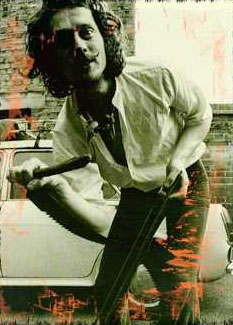| Jamie Muir  Born: ? Born: ?
Birthplace: Edinburgh, Scotland
Gender: Male
Religion: Buddhist
Race or Ethnicity: White
Occupation: Drummer, Artist Nationality: Scotland
Executive summary: Experimental percussionist A performer that recognizes no boundaries to his work, Jamie Muir began his career in music following his expulsion from the Edinburgh Art School in 1966. After an unsatisfying period playing trombone in conventional jazz bands, he switched to drums and percussion and adopted a freer approach to his playing, eventually joining up with the Edinburgh free-jazz ensemble The Assassination Weapon. After two years with the group he was invited by guitarist Derek Bailey to join the ever-changing collective of The Music Improvisation Company, where Muir was given the opportunity to work with many of the leading avant-garde musicians of the time.
In 1971 Muir joined the African-oriented rock band Assagai, in which he performed alongside future National Health co-founder Alan Gowen. The following year Muir and Gowen broke off to form the jazz-rock outfit Sunship, but before the life of the new band was really underway, Muir was lured away by a much more enticing opportunity: an invitation by Robert Fripp to join the next incarnation of King Crimson.
With Crimson, Muir achieved a level of public recognition that surpassed all of his previous and subsequent projects -- a condition that was of no interest at all to the musician. While co-drummer Bill Bruford would hold down the underlying rhythms for the band, Muir would embellish a dizzying array of sounds over the top, utilizing everything from conventional drums to sheets of metal, chains, birdcalls, autoharp, plastic bottles, bags of dead leaves and anything else that was at hand. His unrestrained flow of activity became the focal point of Crimson's 1972 live performances, with both the audience and his fellow musicians never knowing what was going to happen next. At the beginning of 1973, the band entered the studio to attempt to capture this whirlwind of energy, resulting in one of the most significant albums in its catalogue, the Muir-named Lark's Tongues in Aspic.
Almost immediately following the release of Lark's Tongues, Muir left Crimson to pursue a more introspective life. Following the first of a pair of shows at London's Marquee Club, Muir dropped a gong on his foot; this was presented to his fellow musicians by the band's management, EG Records, as the reason for his absence at the next day's performance. In truth, Muir had approached EG with the desire to move on to pursue his spiritual interests, fully intending to explain to his bandmates the motives behind his sudden defection; for reasons that none of the musicians involved understand to this day, EG told Muir that they would talk to the rest of Crimson on his behalf and instead concoted the bogus (and somewhat implausible) story of his injury. Muir subsequently immersed himself in the practice of Buddhism, emerging more than six years later as an ordained Buddhist Monk.
A brief return to music was made in the 1980s, when Muir put together a studio of his own and recorded Ghost Dance with ex-The Flying Lizards leader David Cunningham and fellow former Crimson drummer Michael Giles. A full retirement from music was made in 1990, and Muir has since focused his creative energies on his painting. University: Edinburgh College of Art
Assagai Percussionist (1971)
King Crimson Percussionist (1972-73)
Requires Flash 7+ and Javascript.
Do you know something we don't?
Submit a correction or make a comment about this profile
Copyright ©2019 Soylent Communications
|